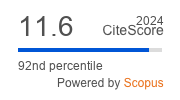ABNORMAL EVENT DETECTION IN PEDESTRIAN PATHWAY USING GARCH MODEL AND MLP CLASSIFIER
DOI:
https://doi.org/10.29284/ijasis.5.2.2019.15-22Keywords:
Abnormal event detection, anomaly detection, GARCH modeling, multilayer perceptron, neural network.Abstract
In computer vision, one of the complex research areas is video surveillance. It is very important to monitor the abnormal events in public places. Due to the technical advances, the usage of cameras is increased for surveillance purpose. As human operators are employed for the observation, their visual attention is reduced after long periods. Hence, an automated Abnormal Event Detection (AED) technique is designed in this study. It uses Generalized Autoregressive Conditional Heteroscedasticity (GARCH) which is a statistical model to model the events occurs in the pedestrian pathway. Before modeling, a series of preprocessing steps are employed to detect the moving objects. Multilayer Perceptron (MLP) is used to classify the parameters of GARCH model as normal event or abnormal event. Results show that the events are modeled by GARCH in an efficient manner which provides promising results for AED.
References
J.C. SanMiguel, J.M. Martínez, and L. Caro-Campos, “Object-size invariant anomaly detection in video-surveillance”, International Carnahan Conference on Security Technology, 2017, pp. 1-6.
X. Zang, G. Li, Z. Li, N. Li, and W. Wang, “An object-aware anomaly detection and localization in surveillance videos”, International Conference on Multimedia Big Data, 2016, pp. 113-116.
J.N. Lv, X.Z. Li, Z.J. Zhang, G.H. Gao, and S.P. Wang, “A Video Storage Algorithm Based on Buffer and Anomaly Detection”, International Conference of Information Science and Management Engineering, 2010, pp. 442-445.
M. Isaloo, and Z. Azimifar, “Anomaly detection on traffic videos based on trajectory simplification”, Iranian Conference on Machine Vision and Image Processing, 2013, pp. 200-203.
Q. Li, and W. Li, “A novel framework for anomaly detection in video surveillance using multi-feature extraction”, international symposium on computational intelligence and design, 2016, pp. 455-459.
J. Wang, and Z. Xu, “Crowd anomaly detection for automated video surveillance”, International Conference on Imaging for Crime Prevention and Detection, 2015, pp. 1-6.
S. Shashikar, and V. Upadhyaya, “Traffic surveillance and anomaly detection using image processing”, International Conference on Image Information Processing, 2017, pp. 1-6.
L. Tran, C. Navasca, and J. Luo, “Video detection anomaly via low-rank and sparse decompositions”, Western New York Image Processing Workshop, 2012, pp. 17-20.
X. Li, W. Li, B. Liu, Q. Liu, and N. Yu, “Object-Oriented Anomaly Detection in Surveillance Videos”, International Conference on Acoustics, Speech and Signal Processing, 2018, pp. 1907-1911.
P. Kaur, M. Gangadharappa, and S. Gautam, “An Overview of Anomaly Detection in Video Surveillance”, International Conference on Advances in Computing, Communication Control and Networking, 2018, pp. 607-614.
D.V. Ngo, N.T. Do, and L.A.T. Nguyen, “Anomaly detection in video surveillance: A novel approach based on sub-trajectory”, International Conference on Electronics, Information, and Communications, 2016, pp. 1-4.
V. Mahadevan, W. Li, V. Bhalodia and N. Vasconcelos, “Anomaly detection in crowded scenes”, IEEE Conference on Computer Vision and Pattern Recognition, 2009, pp. 1975-1981.
Y. Yuan, J. Fang and Q. Wang, “Online anomaly detection in crowd scenes via structure analysis”, IEEE Transactions on Cybernetics, Vol. 45, No. 3, 2005, pp. 548-561.
T. Bollerslev, “Generalized Autoregressive Conditional Heteroskedasticity”, Journal of Econometrics, Vol. 31, No. 3, 1986, pp. 307–327.
Downloads
Published
Issue
Section
License
This work is licensed under a Creative Commons Attribution 4.0 International License, which permits unrestricted use, distribution, and reproduction in any medium, provided the original work is properly cited.











